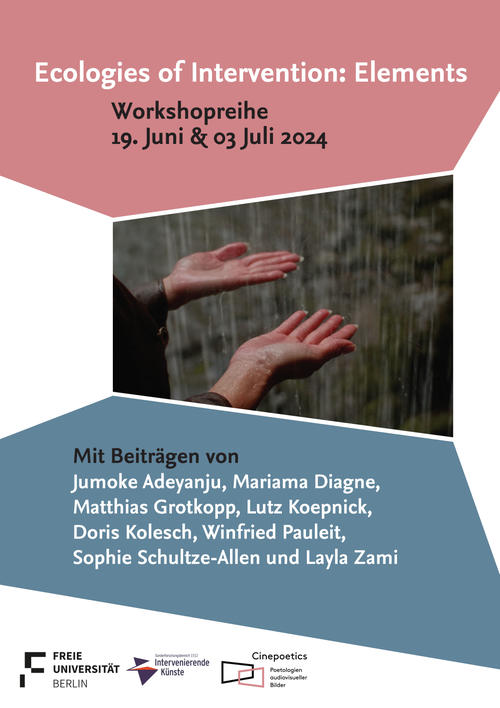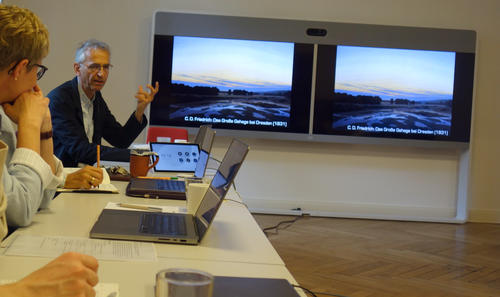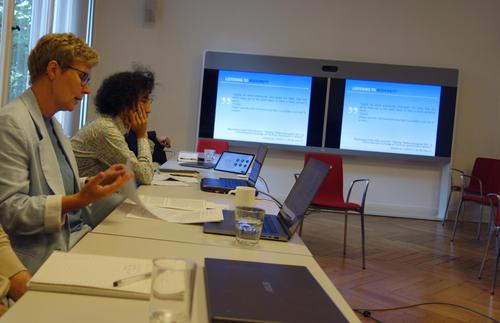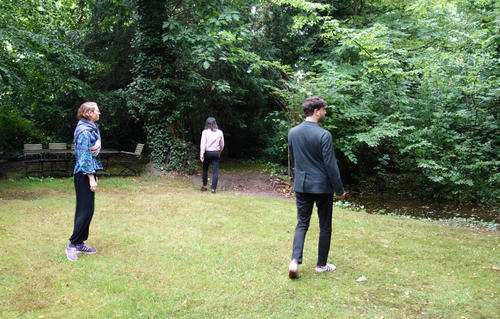Ecologies of Intervention: Elements Part 1
19.06.2024 | Workshop by the CRC 1512 "Intervening Arts" and the Cinepoetics group with Matthias Grotkopp, Doris Kolesch, Winfried Pauleit, Sophie Schultze-Allen und Layla Zami
By taking a closer look at mediations of water and earth, the workshop raised several questions regarding the interventionist potential of the arts in the perception of the elements: How the stubbornness, materiality and movement of the elements become part of artistic practices and how they relate to each other, continued to guide the discussions during the workshop.
The workshop began with two film-theoretical perspectives by Winfried Pauleit and Matthias Grotkopp, both of whom presented their current state of research and thoughts on film-specific depictions of water. The starting point for Pauleit's presentation "Audiovisuelle Wasserlandschaften und Verflechtungen der Moderne: Berlin / Paris" was the consideration of film and cinema as cultural practices of modernity that overlap and interact with others.
To explore how cinema and bathing culture relate to each other, he took a closer look at L'ATALANTE (1934) by Jean Vigo. Besides pointing to similarities in their architectures, appropriation processes, or modes of 'showing off', he illustrated how the film uses its staging of natural soundscapes to make landscapes and especially the element of water audio-visually perceptible. He presented the film as a modernist actualization of an image or imagination of waterscapes from the 19th century.
Matthias Grotkopp, in turn, focused on the experimental documentary MAɬNI - TOWARDS THE OCEAN, TOWARDS THE SHORE by first-nation filmmaker Sky Hopinka. Grotkopp highlighted the fruitful depictions of how the elements, human bodies, and cultural systems interact with one another in indigenous filmmaking. By taking water seriously as a spirit and making it tangible as a form of life, this approach offers another form of world production.
Understanding the movement of water as cinematographic poetics, Grotkopp pointed to the movie’s quote "you can touch the water" and showed how the film translates this instruction as the mode of a kinesthetic image. Thus, the film portrays encounters with water and nature not as something given, but as something that has to be created and maintained, something that requires practice and knowledge.
For the following presentation, "Liquid Listening: From Water to Sonic Waves," Layla Zami und Doris Kolesch thought about a different constitution of listening. Not only were they concerned with listening to liquids, but also with a mode of liquid listening, a ‘fluent’ or ‘gliding’ listening process in the semantic sense.
Starting with some introductory thoughts, Doris Kolesch pointed to the misconception of nature being silent and asked what it is that that we actually hear when it comes to nature? Our perceptions of nature are constantly in resonance with the 'sound worlds' common in a culture and its prefiguration of 'natural' sounds, she explained. As the arts have always imitated sounds, those culturally produced soundscapes have hugely influenced our perception of nature itself. So, when it comes to the elements, according to Kolesch, it is particularly important to realize the extent to which our hearing is culturally conventionalized.
Layla Zami pointed to the potential of the transformation of sound and its possible use in the context of ecological activism: "Liquid listening can make intervening listening possible," she explained. With La Mer (1905) by Claude Debussy and Lamin Fofana’s Life and Death by Water (2022) she gave two examples of how musical works may relate to the experience of water. Especially in Fofana’s case, the different tracks – meaning both, the sound tracks in audio production and the tracks that a foot may leave in the ground – are blurred in favor of a wholistic way of listening. In this way, the mode of liquid listening may intervene in fixed experiential listening patterns like the concept of a 'white male ear.'
The day ended with a practical exercise that aimed to illustrate what it means to listen with the whole body, a listening that requires a multitude of the senses. In her research and practice, PhD student and dance scholar Sophie Schultze-Allen asks herself how somatic practices can help to reconnect people with their environment in a non-anthropocentric way and finds an answer in the idea of somatic or kinesthetic empathy.
In dance practice, as Schultze-Allen pointed out, this concept can relate to how dancers lead and follow each other's movement through touch and contact. Schultze-Allen took inspiration from Shelley Etkin’s artistic research project, Garden as Studio, and invited the participants to a solo exploration in the garden of the premises. After finding a plant for themselves, the participants were encouraged to engage in dialogue with it, by mimicking, following or responding to its movements. After twenty minutes, this praxeological venture into the concept of somatic empathy was discussed by the group, each participant sharing their individual takes on Schultze-Allen’s guiding principle: "to touch the tree is to feel oneself touched by the tree."





